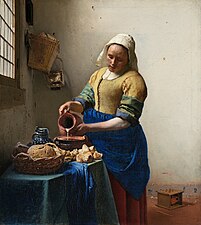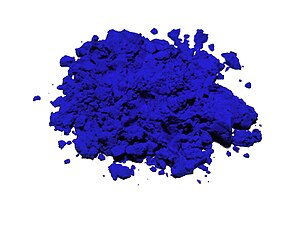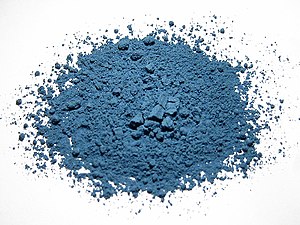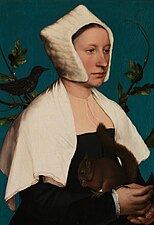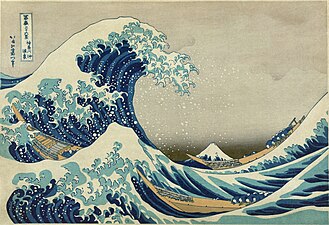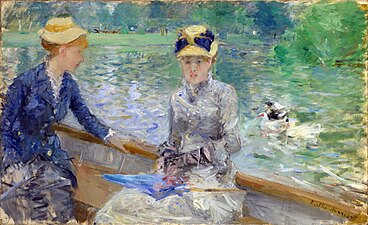Blue pigments
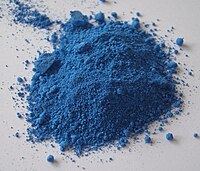
Bluepigmentsare natural or synthetic materials, usually made from minerals and insoluble with water, used to make the blue colors in painting and other arts. The raw material of the earliest blue pigment waslapis lazulifrom mines in Afghanistan, that was refined into the pigmentultramarine.Since the late 18th and 19th century,blue pigmentsare largely synthetic, manufactured in laboratories and factories.
Ultramarine
[edit]Ultramarinewas historically the most prestigious and expensive of blue pigments. It was produced fromlapis lazuli,a mineral whose major source was the mines ofSar-e-Sangin what is now northeastern Afghanistan.[1]It was transformed into a pigment by the Afghans beginning in about the 5th century, and exported by caravans to India. It was the most expensive blue used by Renaissance artists. It was often reserved for special purposes, such as painting the robes of theVirgin Mary.[2]Johannes Vermeerused ultramarine only for the most important surfaces where he wanted to attract attention.Pietro Perugino,in his depiction of the Madonna and Child on theCertosa de Pavio Altarpiece,painted only the top level of the Virgin's robes in ultramarine, withazuritebeneath.[3]
-
Lapis lazuli in its natural state
-
Natural ultramarine
-
TheWilton Diptych(c.1395–1399)
Unknown artist
Ultramarine became more widely used after its successfulsynthesis in the 19th century,which reduced its price substantially. In 1814, a French chemist named Tassaert observed the spontaneous formation of a blue compound, very similar to ultramarine, in alimekilnat St. Gobain. In 1824, theSocieté pour l'Encouragement d'Industrieoffered a prize for the artificial production of the precious color. Processes were devised independently byJean Baptiste Guimet(1826) andChristian Gmelin(1828); while Guimet kept his process a secret, Gmelin published his, and thus became the originator of the French synthetic ultramarine industry. At the beginning of the 19th century, the price of a kilogram of lapis lazuli was between six and ten thousand francs. The price of artificial ultramarine was less than eight hundred francs per kilogram.[4]Synthetic ultramarine was widely appreciated by the French impressionists, andVincent van Goghused both French ultramarine and cobalt blue for his paintingThe Starry Night(1889).[5]
-
Synthetic ( "French" ) ultramarine
Egyptian Blue
[edit]Egyptian bluewas the first synthetic blue pigment. It was made from a mixture ofsilica,lime,copper,and analkali.It was widely used in TheFourth Dynastyof ancient Egypt (c. 2613 to 2494 BC).[6]Egyptian blue is responsible for the blue colour seen very commonly inEgyptian faience.
-
Egyptian blue
-
Faiencesenetboard belonging toAmenhotep III(c.1390-1353 BC)
-
Faiencepyxisfrom northern Syria (c.750-700 BC)
Han blue
[edit]Han blue(also called Chinese blue) is a synthetic barium copper silicate pigment used in ancient and imperial China from theWestern Zhouperiod (1045–771 BC) until the end of theHan dynasty(circa 220 AD). Han blue and the chemically relatedHan purplewere used to decoratehuvessels during the Han dynasty, and were also used for mural paintings in tombs of the same period.[7]
-
Figures in aHan Dynastytomb, painted withHan blue(Before 220 AD)
Maya blue
[edit]Maya blueis a syntheticturquoise-blue pigment made by infusingindigodyes (particularly those derived from theanilshrub) intopalygorskite,a clay that binds and stabilises the indigo such that it becomes resistant to weathering.[8]Developed inMesoamericain the first millennium AD, it saw wide use in the region, most prominently in theartof theMaya civilisation.It is known on media from pottery to murals tocodices,and also played an important role in ritual sacrifices of both objects and people: silt at the bottom of theSacred CenoteatChichén Itzáis heavily stained with Maya blue, washed off the hundreds of sacrificial offerings cast into the cenote during the city's occupation.[9]Maya blue continued to be used into the Spanish colonial period; though falling out of widespread use in the Maya region during the 16th century, some areas apparently continued to produce it for export, asCubancolonial paintings of the 18th and 19th century have been found to make use of Maya blue probably imported fromCampeche.[10]
-
Fresco mural, Temple of the Murals atBonampak(c.790)
-
Pages 34–36 of theMadrid Codex(c. 1200–1500)
Azurite
[edit]Azurite pigmentis derived from the soft, deep-blue copper mineral of the same name, which forms from the weathering of copper ore deposits. It was mentioned inPliny the Elder's Natural Historyunder the Greek name kuanos (κυανός:"deep blue," root of Englishcyan) and the Latin namecaeruleum.The modern English name of the mineral reflects this association, since bothazuriteandazureare derived via Arabic from the Persianlazhward(لاژورد), an area known for its deposits of another deep-blue stone,lapis.Azurite was often used in the Renaissance and later as a less expensive substitute forultramarine.Lower layers would be painted in azurite, with the most visible portions painted in ultramarine. The drawback of the pigment is that it degrades and darkens over time.[11]
-
Azurite crystals found fromLa Sal Mountains,Utah
Prussian Blue
[edit]Prussian blueis a dark bluepigmentcontaining iron and cyanide produced by the oxidation of ferrousferrocyanidesalts. It was invented in Berlin between 1704 and 1710. It had an immediate impact on the pigment market, because its intense deep blue color approached the quality of ultramarine at a much lower price. It was widely adapted by major European artists, notablyThomas GainsboroughandCanaletto,who used it to paint the Venetian sky.[12]It was also used by Japanese artists, includingHokusai,for the deeper blues of waves.
Cerulean blue
[edit]Cerulean bluewas created in 1789 by the Swiss chemistAlbrecht Höpfner.[13]Subsequently, there was a limited German production under the name ofCölinblau.The primary chemical constituent of the pigment iscobalt(II)stannate(Co
2SnO
4).[14]
-
Cerulean blue
Cobalt blue
[edit]Cobalt blueis a synthetic blue pigment was invented in 1803 as a rival to ultramarine. It was made by the process ofsintering,that is by compacting and forming a solid mass of material by heat or pressure without melting it to the point of liquefaction. It combined cobalt(II) oxide with aluminum(III) oxide (alumina) at 1200 °C. It was also used as colorant, particularly in blue glass and as the blue pigment used for centuries in Chineseblue and white porcelain,beginning in the late eighth or early ninth century.[15]
Cobalt glass,orSmalt,is a variation of cobalt blue. It is made of ground blue potassium glass containing cobalt blue. It was widely used in painting in the 16th and the 17th centuries. Smalt was popular because of its low cost; it was widely used by Dutch and Flemish painters, includingHans Holbein the Younger.[16]
-
Cobalt blue
-
La Yole(Boating on the Seine) (c.1879)
Pierre-Auguste Renoir
YInMn Blue
[edit]YInMn Blueis aninorganicpigment with an intense blue color that was discovered byMas Subramanianand his graduate student, Andrew Smith, atOregon State Universityin 2009.[17][18]It has been used in water, oil, and acrylic paints from paint vendors including Derivan,[19][20]Golden,[21]and Gamblin.[22]
The name "YInMn" comes from thechemical symbolsforyttrium,indiumandmanganese.The intense blue color comes from thecrystal structureof the chemical compound, and can be varied by adjusting the ratio of indium and manganese. After discovering this pigment, Subramanian’s research team has used similar principles of colour science to design a range of novel green, purple, and orange pigments.[23][24][25]
-
YInMn Blue powdered pigment
List of inorganic blue pigments
[edit]This is a list of blue inorganic pigments, both natural and synthetic:[26]
Aluminium pigments
- Ultramarine(PB29): a synthetic or naturally occurringsulfur-containingsilicate mineral—Na
8–10Al
6Si
6O
24S
2–4(generalized formula) - Persian blue:made by grinding up the mineralLapis lazuli.The most important mineral component of lapis lazuli islazurite(25% to 40%), a feldspathoid silicate mineral with the formula(Na,Ca)
8(AlSiO
4)
6(S,SO
4,Cl)
1–2.
Cobalt pigments
- Cobalt blue(PB28): cobalt(II) aluminate.
- Cerulean blue(PB35): cobalt(II) stannate.
- Cerium uranium blue
Copper pigments
- Egyptian blue:a synthetic pigment of calcium copper silicate (CaCuSi4O10). Thought to be the first synthetically produced pigment.
- Han blue:BaCuSi4O10.
- Azurite:cupric carbonate hydroxide (Cu3(CO3)2(OH)2).
- Basic copper carbonate:Cu2(OH)2CO3.
Iron pigments
- Prussian blue(PB27): a synthetic inert pigment made ofironandcyanide:C18Fe7N18.
Manganese pigments
- YInMn Blue:a synthetic pigment discovered in 2009 (YIn1−xMnxO3).[17]
- Manganese blue: barium manganate(VI) sulfate.
Notes and citations
[edit]- ^Bomford and Roy, "A Closer Look at Colour" (2009), p. 28-37
- ^Varichon, (2005) p. 164
- ^Pastoureau, Michel, "Bleu - Histoire d'une couleur" (2000), p. 100
- ^Maerz and Paul (1930).A Dictionary of ColorNew York: McGraw Hill p. 206
- ^Yonghui Zhao, Roy S. Berns, Lawrence A. Taplin, James Coddington, An Investigation of Multispectral Imaging for the Mapping of Pigments in Paintings, in Proc. SPIE 6810, Computer Image Analysis in the Study of Art, 681007 (29 February 2008)
- ^McCouat, Philip (2018)."Egyptian blue: The colour of technology".artinsociety.com.Journal of Art in Society. Archived fromthe originalon 2019-03-28.Retrieved2019-05-29.
- ^FitzHugh, E. W. and Zycherman, L. A. 1992. A Purple Barium Copper Silicate Pigment from Early China. Studies in Conservation 28/1, 15–23.
- ^Sánchez del Río, M.; Doménech, A.; Doménech-Carbó, M. T.; Vázquez de Agredos Pascual, M. L.; Suárez, M.; García-Romero, E. (2011). "18". In Galàn, E.; Singer, A. (eds.).Developments in Clay Science 3: Developments in Palygorskite-Sepiolite Research.Elsevier. pp. 453–481.ISBN978-0-444-53607-5.
- ^Arnold, D. E.; Branden, J. R.; Williams, P. R.; Feinman, G. M.; Brown, J. P. (2008). "The first direct evidence for the production of Maya Blue: rediscovery of a technology".Antiquity.82(315): 151–164.doi:10.1017/s0003598x00096514.
- ^Tagle, A. A.; Paschinger, H.; Richard, H.; Infante, G. (1990). "Maya blue: its presence in Cuban colonial wall paintings".Studies in Conservation.35(3): 156–159.doi:10.1179/sic.1990.35.3.156.
- ^Gettens, R.J. and Fitzhugh, E.W., Azurite and Blue Verditer, in Artists’ Pigments. A Handbook of Their History and Characteristics, Vol. 2: A. Roy (Ed.) Oxford University Press 1993, p. 23–24
- ^Bomford and Roy, "A Closer Look - Colour", the National Gallery, London (2009),p. 37
- ^Höpfner, Albrecht (1789). "Einige kleine Chymische Versuche vom Herausgeber".Magazin für die Naturkunde Helvetiens.4:41–47.
- ^"Cerulean blue - Overview".webexhibits.org.Pigments through the Ages.Retrieved20 November2017.
- ^"Chinese pottery: The Yuan dynasty (1206–1368)".Archived2017-12-29 at theWayback MachineEncyclopædia BritannicaOnline. Accessed 7 June 2018.
- ^SmaltPigments through the Ages
- ^abSmith, Andrew E.; Mizoguchi, Hiroshi; Delaney, Kris;Spaldin, Nicola A.;Sleight, Arthur W.; Subramanian, M. A. (2009). "Mn3+in Trigonal Bipyramidal Coordination: A New Blue Chromophore ".J. Am. Chem. Soc.131:17084–17086.doi:10.1021/ja9080666.PMID19899792.
- ^Cascone, Sarah (20 June 2016)."The Chemist Who Discovered the World's Newest Blue Explains Its Miraculous Properties".Artnet News. Archived fromthe originalon 4 April 2020.
- ^"Product Profile: Yin Min Blue".YouTube.Derivan. 12 July 2016.Archivedfrom the original on 5 November 2017.
- ^Cascone, Sarah (19 June 2017)."The Wild Blue Yonder: How the Accidental Discovery of an Eye-Popping New Color Changed a Chemist's Life".Artnet.Retrieved15 May2019.
- ^"Update on YInMn Blue from GOLDEN's Custom Lab".2021-04-23.Retrieved2021-08-18.
- ^"Gamblin YInMn Blue".
- ^Smith, Andrew E.; et al. (October 2016)."Spectral properties of the UV absorbing and near-IR reflecting blue pigment, YIn1−xMnxO3".Dyes and Pigments.133:214–221.doi:10.1016/j.dyepig.2016.05.029.
- ^Li, Jun & Subramanian, M. A. (April 2019)."Inorganic pigments with transition metal chromophores at trigonal bipyramidal coordination: Y(In,Mn)O3blues and beyond ".Journal of Solid State Chemistry.272:9–20.Bibcode:2019JSSCh.272....9L.doi:10.1016/j.jssc.2019.01.019.S2CID104373418.
- ^Li, Jun; et al. (13 September 2016)."From Serendipity to Rational Design: Tuning the Blue Trigonal Bipyramidal Mn3+Chromophore to Violet and Purple through Application of Chemical Pressure ".Inorganic Chemistry.55(19): 9798–9804.doi:10.1021/acs.inorgchem.6b01639.PMID27622607.
- ^Völz, Hans G.; et al. "Pigments, Inorganic".Ullmann's Encyclopedia of Industrial Chemistry.Weinheim: Wiley-VCH.doi:10.1002/14356007.a20_243.pub2.ISBN978-3527306732..
Bibliography
[edit]- Pastoureau, Michel (2000).Bleu: Histoire d'une couleur(in French). Paris: Editions du Seuil.ISBN978-2-02-086991-1.
- Varichon, Anne (2005).Couleurs: pigments et teintures dans les mains des peuples(in French). Paris: Editions du Seuil.ISBN978-2-02-084697-4.
- Bomford, David; Roy, Ashok (2009).A Closer Look - Colour.London: National Gallery.ISBN978-1857094428.





